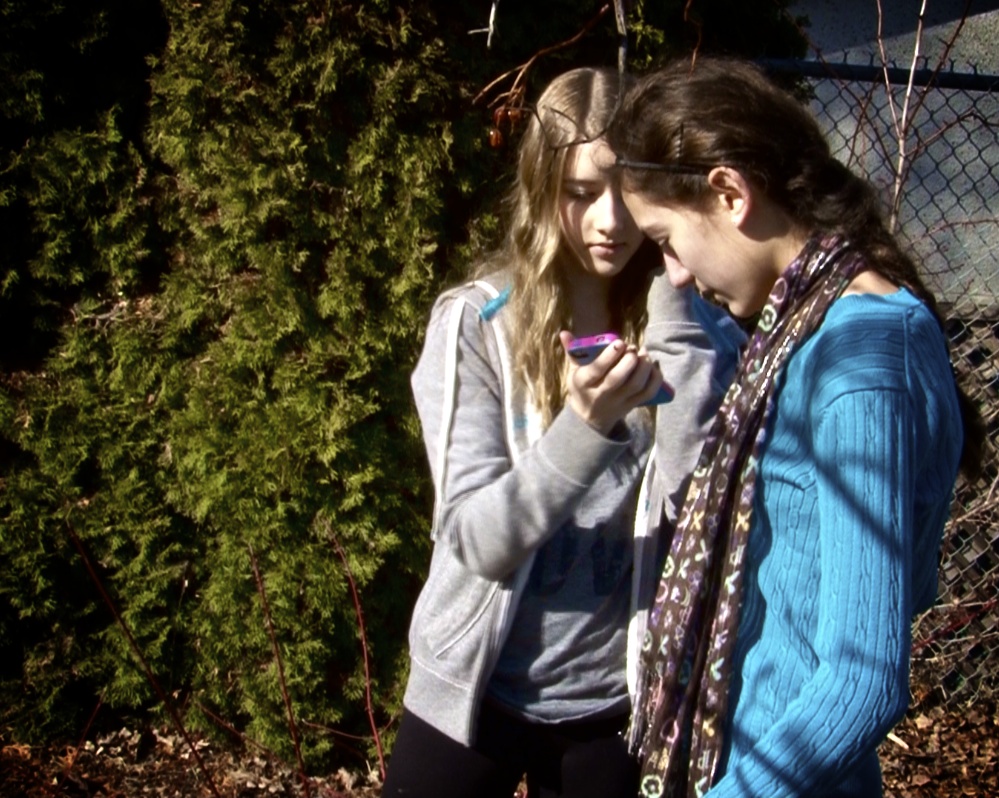CLICK TO EXPERIENCE THE INTERACTIVE-AUDIOSCAPE-POEM
The students at École K.L.O. Middle School and I have been using eco art to help us gain a more full, embodied understanding of the knowledge available to us through the information database of the natural more-than-human world. In ‘Listen Up Here,’ a web-based interactive audioscape poetry project, we found it necessary to discover — almost by “accident” — and embody our natural surroundings which teach us. In order for the students to be able to do this, we have to let these surroundings come to us. Walking and listening allow this kind of transformation to take place and we become informed because we have let it happen serendipitously. Sound in particular is something we almost always tune out and are most “blind” to and unaware of. This eco art action allowed the students to open up to their natural world in a way conducive to serendipitous discovery, a way that they may have used very minimally until now.
This project consisted of two parts: a discovery and gathering part, and an editing and assembling part. The former took place prominently in the green spaces and backyards accessible to the students in their everyday lives; the latter, on a computer running a Google Chrome web-app designed for audio and video editing.
For the first part of the project, I asked the students to explore their local green spaces and backyards; I asked them to go into the natural areas they know (be they on the school grounds or elsewhere) that they feel have something to teach them, and listen. Then, when they were to hear something interesting, something different, something mundane, or simply something noticed, record it and bring it to class on — the devices almost as familiar to these students as their own hands — their smart phones. We had a few of these sessions in the in-ground school gardens theses same students have planted and tended to in their environmental education classes in which we would walk and listen. They then gave each other audio tours where, as a group, they would go over the school grounds with audio recordings they had by then collected on their phones and collectively share a mix of sounds they felt communicated and accentuated the sounds of that part of their tours.
Sacha Kagan, researcher and advocate of walking practices in sustainability and the arts, has this to say about serendipitous discovery of information through use of the body. “Walking is not only an everyday practice characterizing the human being, but also a very rich form of action research. It allows embodied learning. Walking-based practices put learned things in contexts, locally and ecologically, embedded in a real geography and not only conveniently virtual. Thanks to the slower rhythm, the walker heightens his or her attention. Walking across places involves moving, exchanging, comparing. Walking is transversal because the transversal is that which cuts across, walks across, different levels of reality, not only bridging them, but also traveling beyond them. Walking can even become a genuinely transversal.”
For the second part we used the class set of laptops to edit these sounds into audioscape poems based on Andrea Rawlings’ soundscape based ‘Visual Poems.’ But something changed when this element was introduced to the project. With the computers in the classroom, an un-embodied, distraction prone medium, the students became distant from the project. I observed students who were usually incredibly inspired, very active, and enthusiastic when working outdoors, all of a sudden disconnect and take twice as long to be half as productive as before; even the simplest tasks such as loading media into a web-app would take almost an entire class. While I was trying to find a balance with technology (which I feel was successful using the phones as audio recorders in part 1), with the computer interface, the technology became overwhelming not because the technology was particularly inaccessible or complicated. From my point of view it seemed that this was because the students were no longer in their bodies as there was no longer a need to use them when all the information (and games) only required their fingertips. All that embodied discovery from part 1 became quickly undone.
The first half of this was exactly what was needed for this project but once technology took over it fell apart. My theory here is that technology can be used in small bursts, in combination with nature, and in combination with the use of our entire entities (our bodies), but it must be a technology with simple variables and one that is well understood by the user (such as the students’ phones) — technology is essentially structure and thus requires structure to operate efficiently; when structures becomes too complicated, they falls apart. This is because it is un-embodied and thus distraction prone. On this platform, discoveries are limited and we default to the things we know (such as games or Facebook) and they do not allow us to discover further than their limitations. This of course being specific to user-friendly technology, coding is as close a technological relative to nature as possible but it is incredibly inaccessible and remains entirely disconnected from the human body at present. When we go, as Kagan would suggest, on a walk, all our senses are alive, and we are receptive and open to discovery; in a sense, we enable ourselves to be compatible with the information database that is the natural world.
For more from Shimshon Obadia, visit www.ShimshonObadia.com
